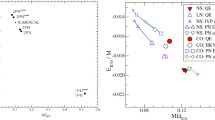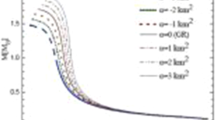Abstract
In a model galaxy composed of a relativistically active nucleus, a main body, and a halo, all three components considered as homogeneous prolate ellipsoids, we explore the probable association of the internal characteristics of the nucleus and the observed orbits of the stars near the surface of the main body. Using the authors’ theoretical framework of post-Newtonian general relativistic galactic dynamics, proposed earlier, we prove that a fast-rotating and possibly expanding or contracting nucleus affects the distribution of the box-type orbits near the surface of the main body resulting in a flattening of the main body. The nuclear rotation always results in a flattening, and the contraction contributes less to the flattening than the expansion. However, the contributions of a rotating and changing nucleus are not additive. The study of the post-Newtonian effects in the nucleus on the stellar orbits in the main body, and the consequent modifications of the corresponding non-relativistic results, could in principle provide useful information concerning the kinematical and dynamical characteristics of the nuclei of the elliptical galaxies. The explanation (of at least the post-Newtonian part) of the flattening of elliptical galaxies attempted here seems to be the first theoretical one proposed in the literature.
Similar content being viewed by others
References
Bergval, N., Johansson, L. 1985,Astr. Astrophys.,149, 475.
Bertola, F. 1981,Sky Telesc,61, 380.
Bertola, F., Capaccioli, M. 1978,Astrophys. J.,219, L95.
Bertola, F., Galleta, G. 1978,Astrophys. J.,226, L115.
Biermann, P., Strom, R., Bartel, N. 1985,Astr. Astrophys.,147, L27.
Binney, J. 1976,Mon. Not. R. Astr. Soc.,177, 19.
Binney, J., Gerhard, O. E., Piet, H. 1984, Max-Planck-Institut für Astrophysik Green Report No. MPA 134.
Blandford, R. D. 1984, inProc. Active Galactic Nuclei, (Manchester) Caltech Goldenrod Preprint No. GRP-021.
Chandrasekhar, S. 1969,Ellipsoidal Figures of Equilibrium, Yale Univ. Press, New Haven.
Contopoulos, G. 1960,Z. Astrophys.,49, 273.
Contopoulos, G. 1983, inIAU Symp. 104:Early Evolution of the Universe and its Present Structure, Eds G. O. Abell & G. Chincarini, D. Reidel, Dordrecht, p. 417.
Contopoulos, G., Spyrou, N. 1976,Astrophys. J.,205, 592.
Danks, A. C., Materne, J. 1984,Astr. Astrophys.,139, 455.
Dicke, R. H., Goldenberg, H. M. 1967,Phys. Rev. Lett.,18, 313.
Gerhard, O. 1985, Max-Planck-Institut für Astrophysik Green Report No. MPA 187.
Gerhard, O., Binney, J. 1985, Max-Planck-Institut für Astrophysik Green Report No. MPA 175.
Hoffman, G. L., Sapleter, E. E. 1982,Astrophys. J.,263, 485.
Spyrou, N. 1977,Gen. Relativ. Grav.,8, 463.
Spyrou, N. 1978,Celest. Mech.,18, 351.
Spyrou, N., Dionysiou, D. 1973,Astrophys. J.,183, 265.
Spyrou, N., Varvoglis, H. 1982,Astrophys. J.,255, 674 (Paper I).
Spyrou, N., Varvoglis, H. 1983, inProc. Seventh European Regional Astronomy Meeting, Florence.
Tayler, R. J. 1978,Galaxies: Structure and Evolution, Wykeham Publ., London.
van Albada, T. S., Sanders, R. H. 1982,Mon. Not. R. ast. Soc,201, 303.
Author information
Authors and Affiliations
Rights and permissions
About this article
Cite this article
Spyrou, N., Varvoglis, H. Stellar orbits in elliptical galaxies with relativistically active nuclei. J Astrophys Astron 8, 1–16 (1987). https://doi.org/10.1007/BF02714248
Received:
Accepted:
Issue Date:
DOI: https://doi.org/10.1007/BF02714248




